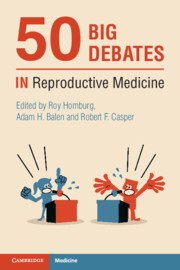Book contents
- 50 Big Debates in Reproductive Medicine
- Series page
- 50 Big Debates in Reproductive Medicine
- Copyright page
- Contents
- Contributors
- Foreword
- Introduction
- Section I Limits for IVF
- Section II IVF Add-ons
- Section III The Best Policy
- Section IV Embryology
- Section V Ethics and Statistics
- Section VI Male-factor Infertility
- Section VII Genetics
- Section VIII Ovarian Stimulation
- 41A AMH Is a Better Predictor of Ovarian Response Than AFC
- 41B AMH Is a Better Predictor of Ovarian Response Than AFC
- 42A Pituitary Suppression Using GnRH Agonist for IVF Is Outdated
- 42B Pituitary Suppression Using GnRH Agonist for IVF Is Outdated
- 43A The Maximum Effective Dose of FSH for Ovarian Stimulation in IVF Is 300 IU
- 43B The Maximum Effective Dose of FSH for Ovarian Stimulation in IVF Is 300 IU
- 44A There Is No Place for Natural and Mild Stimulation IVF
- 44B There Is No Place for Natural and Mild Stimulation IVF
- Section IX Hormones and the Environment
- Index
- References
44A - There Is No Place for Natural and Mild Stimulation IVF
For
from Section VIII - Ovarian Stimulation
Published online by Cambridge University Press: 25 November 2021
- 50 Big Debates in Reproductive Medicine
- Series page
- 50 Big Debates in Reproductive Medicine
- Copyright page
- Contents
- Contributors
- Foreword
- Introduction
- Section I Limits for IVF
- Section II IVF Add-ons
- Section III The Best Policy
- Section IV Embryology
- Section V Ethics and Statistics
- Section VI Male-factor Infertility
- Section VII Genetics
- Section VIII Ovarian Stimulation
- 41A AMH Is a Better Predictor of Ovarian Response Than AFC
- 41B AMH Is a Better Predictor of Ovarian Response Than AFC
- 42A Pituitary Suppression Using GnRH Agonist for IVF Is Outdated
- 42B Pituitary Suppression Using GnRH Agonist for IVF Is Outdated
- 43A The Maximum Effective Dose of FSH for Ovarian Stimulation in IVF Is 300 IU
- 43B The Maximum Effective Dose of FSH for Ovarian Stimulation in IVF Is 300 IU
- 44A There Is No Place for Natural and Mild Stimulation IVF
- 44B There Is No Place for Natural and Mild Stimulation IVF
- Section IX Hormones and the Environment
- Index
- References
Summary
The number of eggs retrieved is an important prognostic factor for IVF outcome, with low egg number associated with a lower likelihood of success. ‘Natural’ and ‘mild’ approaches to ovarian stimulation for IVF intentionally aim to limit the number of eggs retrieved. Hence, they are less effective than standard regimes at achieving live birth, particularly on a cumulative basis. In poor responders, these approaches yield fewer eggs and a higher cancellation rate. The risk of OHSS with standard regimes can be managed using GnRH antagonist, agonist trigger and freeze-all, without compromising the likelihood of live birth. Embryo aneuploidy is not increased by exogenous gonadotropin use. Hence, there is evidence that ‘natural’ and ‘mild’ stimulation reduces the likelihood of having a baby, and no evidence that the risks of standard stimulation are high enough to justify use of ‘natural’ and ‘mild’ IVF in modern practice.
- Type
- Chapter
- Information
- 50 Big Debates in Reproductive Medicine , pp. 228 - 229Publisher: Cambridge University PressPrint publication year: 2021



